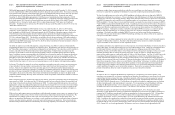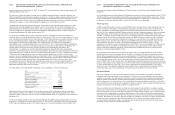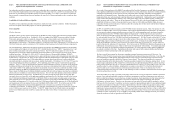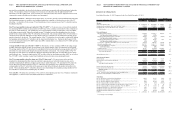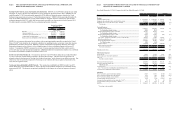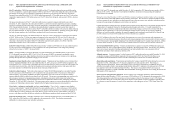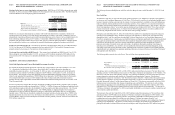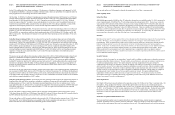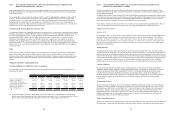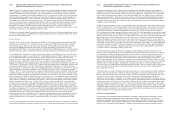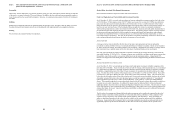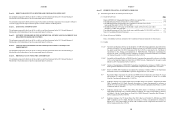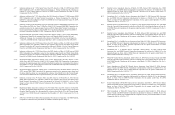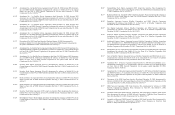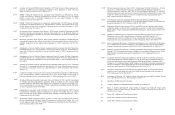Dish Network 2012 Annual Report Download - page 43
Download and view the complete annual report
Please find page 43 of the 2012 Dish Network annual report below. You can navigate through the pages in the report by either clicking on the pages listed below, or by using the keyword search tool below to find specific information within the annual report.
Item 7. MANAGEMENT’S DISCUSSION AND ANALYSIS OF FINANCIAL CONDITION AND
RESULTS OF OPERATIONS - Continued
74
74
Earnings before interest, taxes, depreciation and amortization. EBITDA was $3.857 billion during the year ended
December 31, 2011, an increase of $901 million or 30.5% compared to the same period in 2010. The following table
reconciles EBITDA to the accompanying financial statements.
2011 2010
EBITDA.................................................................... 3,856,542$ 2,955,786$
Interest expense, net................................................ (523,556) (429,619)
Income tax (provision) benefit, net.......................... (895,006) (557,473)
Depreciation and amortization................................. (922,073) (983,965)
Net income (loss) attributable to DISH Network...... 1,515,907$ 984,7 29$
For the Years Ended
December 31,
(In tho us ands)
EBITDA is not a measure determined in accordance with GAAP and should not be considered a substitute for
operating income, net income or any other measure determined in accordance with GAAP. EBITDA is used as a
measurement of operating efficiency and overall financial performance and we believe it to be a helpful measure for
those evaluating companies in the pay-TV industry. Conceptually, EBITDA measures the amount of income
generated each period that could be used to service debt, pay taxes and fund capital expenditures. EBITDA should
not be considered in isolation or as a substitute for measures of performance prepared in accordance with GAAP.
Income tax (provision) benefit, net. Our income tax provision was $895 million during the year ended December
31, 2011, an increase of $338 million compared to the same period in 2010. The increase in the provision was
primarily related to the increase in “Income (loss) before income taxes.”
Net income (loss) attributable to DISH Network. “Net income (loss) attributable to DISH Network” was $1.516
billion during the year ended December 31, 2011, an increase of $531 million compared to $985 million for the
same period in 2010. The increase was primarily attributable to the changes in revenue and expenses discussed
above.
LIQUIDITY AND CAPITAL RESOURCES
Cash, Cash Equivalents and Current Marketable Investment Securities
We consider all liquid investments purchased within 90 days of their maturity to be cash equivalents. See “Item
7A. – Quantitative and Qualitative Disclosures About Market Risk” for further discussion regarding our
marketable investment securities. As of December 31, 2012, our cash, cash equivalents and current marketable
investment securities totaled $7.238 billion compared to $2.041 billion as of December 31, 2011, an increase of
$5.197 billion. This increase in cash, cash equivalents and current marketable investment securities was primarily
related to cash generated from operations of $2.012 billion, the net proceeds of $4.387 billion related to the issuance
of our long-term debt and an increase of $187 million in the value of certain marketable investment securities,
partially offset by capital expenditures of $958 million and the $453 million dividend paid in cash on our Class A and
Class B common stock.
We have investments in various debt and equity instruments including corporate bonds, corporate equity securities,
government bonds and variable rate demand notes (“VRDNs”). VRDNs are long-term floating rate municipal bonds
with embedded put options that allow the bondholder to sell the security at par plus accrued interest. All of the put
options are secured by a pledged liquidity source. Our VRDN portfolio is comprised mainly of investments in
municipalities, which are backed by financial institutions or other highly rated obligors that serve as the pledged
liquidity source. While they are classified as marketable investment securities, the put option allows VRDNs to be
liquidated generally on a same day or on a five business day settlement basis. As of December 31, 2012 and 2011,
we held VRDNs, within our current marketable investment securities portfolio, with fair values of $130 million and
$161 million, respectively.
Item 7. MANAGEMENT’S DISCUSSION AND ANALYSIS OF FINANCIAL CONDITION AND
RESULTS OF OPERATIONS - Continued
75
75
The following discussion highlights our cash flow activities during the years ended December 31, 2012, 2011 and
2010.
Free Cash Flow
We define free cash flow as “Net cash flows from operating activities” less “Purchases of property and equipment,”
as shown on our Consolidated Statements of Cash Flows. We believe free cash flow is an important liquidity metric
because it measures, during a given period, the amount of cash generated that is available to repay debt obligations,
make investments, fund acquisitions and for certain other activities. Free cash flow is not a measure determined in
accordance with GAAP and should not be considered a substitute for “Operating income,” “Net income,” “Net cash
flows from operating activities” or any other measure determined in accordance with GAAP. Since free cash flow
includes investments in operating assets, we believe this non-GAAP liquidity measure is useful in addition to the
most directly comparable GAAP measure “Net cash flows from operating activities.”
During the years ended December 31, 2012, 2011 and 2010, free cash flow was significantly impacted by changes in
operating assets and liabilities and in “Purchases of property and equipment” as shown in the “Net cash flows from
operating activities” and “Net cash flows from investing” sections, respectively, of our Consolidated Statements of
Cash Flows included herein. Operating asset and liability balances can fluctuate significantly from period to period and
there can be no assurance that free cash flow will not be negatively impacted by material changes in operating assets
and liabilities in future periods, since these changes depend upon, among other things, management’s timing of
payments and control of inventory levels, and cash receipts. In addition to fluctuations resulting from changes in
operating assets and liabilities, free cash flow can vary significantly from period to period depending upon, among
other things, subscriber growth, subscriber revenue, subscriber churn, subscriber acquisition costs including amounts
capitalized under our equipment lease programs, operating efficiencies, increases or decreases in purchases of property
and equipment, and other factors.
The following table reconciles free cash flow to “Net cash flows from operating activities.”
2012 2011 2010
Free cash flow........................................................... 1,054,309$ 1,794,973$ 923,670$
Add back:
Purchases of property and equipment................... 957,566 778,905 1,216,132
Net cash flows from operating activities................... 2,011,875$ 2,573,878$ 2,139,802$
For the Years Ended December 31,
(In thousands)
The decrease in free cash flow from 2011 to 2012 of $741 million resulted from a decease in “Net cash flows from
operating activities” of $562 million and an increase in “Purchases of property and equipment” of $179 million. The
decrease in “Net cash flows from operating activities” was primarily attributable to a $1.271 billion decrease of net
income adjusted to exclude non-cash charges for “Depreciation and amortization” expense, “Realized and
unrealized losses (gains) on investments,” and “Deferred tax expense (benefit),” which includes the negative impact
of $676 million of payments for the Voom Settlement Agreement. See Note 16 in the Notes to our Consolidated
Financial Statements in Item 15 of this Annual Report on Form 10-K. This decrease was partially offset by a $684
million increase in cash resulting from changes in operating assets and liabilities. The increase in cash resulting
from changes in operating assets and liabilities is principally attributable to the unfavorable impact in 2011 of the
settlement of the TiVo litigation and timing differences between book expense and tax payments. The increase in
“Purchases of property and equipment” in 2012 was primarily attributable to an increase in satellite construction and
other corporate capital expenditures.
The increase in free cash flow from 2010 to 2011 of $871 million resulted from an increase in “Net cash flows from
operating activities” of $434 million and a decrease in “Purchases of property and equipment” of $437 million. The
increase in “Net cash flows from operating activities” was primarily attributable to a $895 million increase in cash
resulting from net income, adjusted to exclude non-cash changes in “Deferred tax expense (benefit),” and
“Depreciation and amortization” expense, partially offset by a $502 million decrease in cash resulting from changes in
operating assets and liabilities. The decrease in cash resulting from changes in operating assets and liabilities is
principally attributable to timing differences between book expense and cash payments and $350 million in payments



